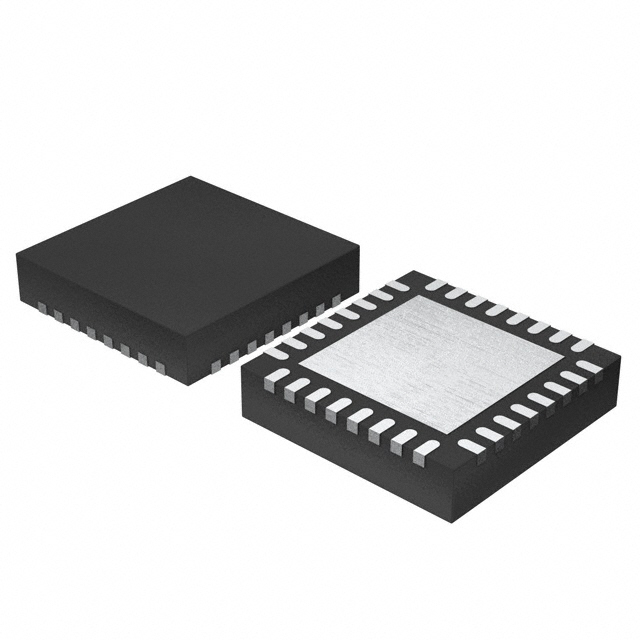Viz Specifikace pro podrobnosti o produktu.

LTC3883EUH#PBF
Product Overview
Category
The LTC3883EUH#PBF belongs to the category of power management integrated circuits (PMICs).
Use
It is primarily used for voltage regulation and power management in various electronic devices.
Characteristics
- High efficiency
- Wide input voltage range
- Precise output voltage control
- Integrated protection features
Package
The LTC3883EUH#PBF comes in a compact 38-lead QFN package.
Essence
The essence of LTC3883EUH#PBF lies in its ability to efficiently regulate and manage power in electronic devices, ensuring stable and reliable operation.
Packaging/Quantity
The product is typically packaged in reels and available in quantities suitable for both small-scale and large-scale production.
Specifications
- Input Voltage Range: 4.5V to 60V
- Output Voltage Range: Programmable from 0.5V to 5.5V
- Maximum Output Current: Up to 25A
- Efficiency: Up to 95%
- Switching Frequency: Adjustable up to 1MHz
- Operating Temperature Range: -40°C to 125°C
Detailed Pin Configuration
The LTC3883EUH#PBF has a total of 38 pins. The pin configuration is as follows:
- VIN: Input voltage
- GND: Ground
- VOUT: Output voltage
- FB: Feedback pin for voltage regulation
- EN: Enable pin
- SS/TRK: Soft-start/tracking pin
- ITH: Current sense threshold pin
- PGND: Power ground
- ...
(Note: Please refer to the product datasheet for the complete pin configuration.)
Functional Features
- Voltage regulation with high precision
- Current sensing and limiting
- Overvoltage and undervoltage protection
- Overcurrent protection
- Thermal shutdown protection
- Soft-start and tracking capabilities
Advantages and Disadvantages
Advantages
- High efficiency leads to reduced power consumption
- Wide input voltage range allows for versatile applications
- Precise output voltage control ensures stable operation of connected devices
- Integrated protection features enhance system reliability
Disadvantages
- May require additional external components for certain applications
- Complex pin configuration may require careful design considerations
Working Principles
The LTC3883EUH#PBF operates based on a switching regulator topology. It utilizes high-frequency switching to efficiently convert the input voltage to the desired output voltage. The feedback mechanism continuously adjusts the duty cycle of the switching signal to maintain the output voltage within the specified range. Various protection features ensure safe operation under different conditions.
Detailed Application Field Plans
The LTC3883EUH#PBF finds application in a wide range of electronic devices, including but not limited to: - Industrial equipment - Telecommunications systems - Automotive electronics - Data storage devices - Consumer electronics
In industrial equipment, it can be used for power management in motor drives, robotics, and factory automation systems. In telecommunications, it enables efficient power conversion in base stations and network infrastructure. In automotive electronics, it contributes to voltage regulation in electric vehicles and hybrid systems. In data storage devices, it ensures reliable power supply to hard drives and solid-state drives. In consumer electronics, it is suitable for use in smartphones, tablets, and portable gaming devices.
Detailed and Complete Alternative Models
- LTC3880EUH#PBF: Similar to LTC3883EUH#PBF with slightly different specifications.
- LTC3882EUH#PBF: Offers higher maximum output current compared to LTC3883EUH#PBF.
- LTC3884EUH#PBF: Provides additional features such as power sequencing and margining.
(Note: Please refer to the respective datasheets for detailed specifications of alternative models.)
In conclusion, the LTC3883EUH#PBF is a versatile power management integrated circuit that offers high efficiency, precise voltage regulation, and integrated protection features. Its wide range of applications and availability of alternative models make it a popular choice in various electronic devices.
Seznam 10 běžných otázek a odpovědí souvisejících s aplikací LTC3883EUH#PBF v technických řešeních
Sure! Here are 10 common questions and answers related to the application of LTC3883EUH#PBF in technical solutions:
Q: What is LTC3883EUH#PBF? A: LTC3883EUH#PBF is a high-performance dual-output digital DC/DC controller designed for power supply applications.
Q: What are the key features of LTC3883EUH#PBF? A: The key features include dual-phase operation, digital power system management, PMBus interface, and wide input voltage range.
Q: What is the maximum output current supported by LTC3883EUH#PBF? A: LTC3883EUH#PBF can support up to 25A of continuous output current per phase.
Q: Can LTC3883EUH#PBF be used in both step-down and step-up applications? A: No, LTC3883EUH#PBF is specifically designed for step-down (buck) applications only.
Q: Does LTC3883EUH#PBF require an external microcontroller for operation? A: No, LTC3883EUH#PBF has an integrated digital control loop and does not require an external microcontroller.
Q: What is the operating temperature range of LTC3883EUH#PBF? A: LTC3883EUH#PBF can operate within a temperature range of -40°C to 125°C.
Q: Can LTC3883EUH#PBF support synchronous rectification? A: Yes, LTC3883EUH#PBF supports synchronous rectification for improved efficiency.
Q: Is there any protection mechanism built into LTC3883EUH#PBF? A: Yes, LTC3883EUH#PBF includes various protection features like overvoltage protection, undervoltage lockout, and overcurrent protection.
Q: Can LTC3883EUH#PBF be used in automotive applications? A: Yes, LTC3883EUH#PBF is suitable for automotive applications as it meets the necessary requirements.
Q: What are some typical applications of LTC3883EUH#PBF? A: LTC3883EUH#PBF can be used in a wide range of applications such as servers, telecom equipment, industrial systems, and power distribution modules.
Please note that these answers are general and may vary depending on specific design considerations and requirements.

